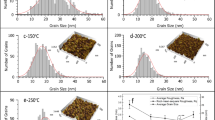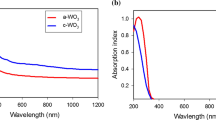Abstract
This study aims to investigate the application of amorphous carbon nitride (CNx) as an alternative anti-reflection coating (ARC) to crystalline silicon solar cells. The CNx films were deposited by reactive RF magnetron sputtering. The measured optical constants were used as input parameters in the PC1D program to simulate the photovoltaic performance of the solar cells. The impact of various refractive indexes and the thickness of the CNx coating as ARC were investigated. Findings revealed that the average reflectance was reduced by 64% using the CNx coating in the 300–1300 nm wavelength range. At the optimum thickness of 85 nm, the power conversion efficiency has increased by 57% compared with the bare silicon solar cell. The results confirm that the contribution to efficiency improvement comes from the gain in short circuit current density rather than the increment in open-circuit voltage. Results also show that the fill factor has an insignificant contribution to efficiency improvement. The external quantum efficiency (EQE) for coating thicknesses between 70 and 90 nm increased by 69% at a wavelength of 600 nm. The present simulation study confirmed that the application of CNx coating is a potential candidate as ARC material for efficient c-Si solar cells.
Similar content being viewed by others
Data Availability
The datasets generated during and/or analyzed during the current study are available from the corresponding author Ali J. Addie on reasonable request.
References
Behera S, Fry PW, Francis H, Jin CY, Hopkinson M (2020) Broadband, wide-angle antireflection in GaAs through surface nano-structuring for solar cell applications. Sci Rep 10(1):1–10. https://doi.org/10.1038/s41598-020-63327-7
Oh G, Kim Y, Lee SJ, Kim EK (2020) Broadband antireflective coatings for high efficiency InGaP/GaAs/InGaAsP/InGaAs multi-junction solar cells. Sol Energy Mater Sol Cells 207(December 2019):110359. https://doi.org/10.1016/j.solmat.2019.110359
Ding J et al (2020) A laser texturing study on multi-crystalline silicon solar cells. Sol Energy Mater Sol Cells 214(December 2019):110587. https://doi.org/10.1016/j.solmat.2020.110587
Greulich J et al (2015) Optical simulation and analysis of Iso-textured silicon solar cells and modules including light trapping. Energy Procedia 77:69–74. https://doi.org/10.1016/j.egypro.2015.07.011
Baryshnikova KV, Petrov MI, Babicheva VE, Belov PA (2016) Plasmonic and silicon spherical nanoparticle antireflective coatings. Sci Rep 6(March):1–11. https://doi.org/10.1038/srep22136
Amalathas AP, Alkaisi MM (2019) Nanostructures for light trapping in thin film solar cells. Micromachines 10:1–18. https://doi.org/10.3390/mi10090619
Schmidt J, Peibst R, Brendel R (2018) Surface passivation of crystalline silicon solar cells: Present and future. Sol Energy Mater Sol Cells 187(January):39–54. https://doi.org/10.1016/j.solmat.2018.06.047
Uzum A, Kanmaz I (2021) Passivation properties of HfO2-SiO2 mixed metal oxide thin films with low reflectivity on silicon substrates for semiconductor devices. Thin Solid Films 738:138965. https://doi.org/10.1016/J.TSF.2021.138965
Sun X et al (2020) Preparation of MgF2/SiO2 coating with broadband antireflective coating by using sol–gel combined with electron beam evaporation. Opt Mater (Amst) 101(January):2–10. https://doi.org/10.1016/j.optmat.2020.109739
Liu B, Qiu S, Chen N, Du G, Sun J (2013)Double-layered silicon nitride antireflection coatings for multicrystalline silicon solar cells. Mater Sci Semicond Process 16(3):1014–1021. https://doi.org/10.1016/j.mssp.2013.02.019
Zahid MA, Khokhar MQ, Cui Z, Park H, Yi J (2021) Improved optical and electrical properties for heterojunction solar cell using Al2O3/ITOdouble-layer anti-reflective coating. Results Phys 28:104640. https://doi.org/10.1016/J.RINP.2021.104640
Saive R (2021) Light trapping in thin silicon solar cells: A review on fundamentals and technologies. Prog Photovolt Res Appl 29(10):1125–1137. https://doi.org/10.1002/pip.3440
Bashir Khan S, Wu H, Pan C, Zhang Z (2017) A mini review: Antireflective coatings processing techniques, applications and future perspective. Res Rev J Mater Sci 05(06):36–54. https://doi.org/10.4172/2321-6212.1000192
Kanda H et al (2016) Al2O3 /TiO2 double layer anti-reflection coating film for crystalline silicon solar cells formed by spray pyrolysis. Energy Sci Eng 4(4):269–276. https://doi.org/10.1002/ese3.123
Jhansirani K, Dubey RS, More MA, Singh S (2016) Deposition of silicon nitride films using chemical vapor deposition for photovoltaic applications. Results Phys 6:1059–1063. https://doi.org/10.1016/j.rinp.2016.11.029
Silva JA, Quoizola S, Hernandez E, Thomas L, Massines F (2014) Silicon carbon nitride films as passivation and antireflective coatings for silicon solar cells. Surf Coat Technol 242:157–163. https://doi.org/10.1016/j.surfcoat.2014.01.037
Li M, Shen H, Zhuang L, Chen D, Liang X (2014) SiO2antireflection coatings fabricated by electron-beam evaporation for black monocrystalline silicon solar cells. Int J Photoenergy 2014. https://doi.org/10.1155/2014/670438
Baek SH, Noh BY, Shin JK, Kim JH (2012) Optical and photovoltaic properties of silicon wire solar cells with controlled ZnO nanorods antireflection coating. J Mater Sci 47(9):4138–4145. https://doi.org/10.1007/s10853-012-6268-7
Ismail RA, Mousa AM, Hussain ZT (2017) Preparation and characteristics study of diamond like carbon / silicon heterojunction photodetector by pulsed laser deposition. Opt Quantum Electron 1–15. https://doi.org/10.1007/s11082-017-1204-3
Nauryzbekova S, Nussupov K, Bakranova D (2022) “Simulation of Antireflective coatings system based on Porous Si/DLC and SiO2/TiO2 for Si solar cells,” Mater Today Proc 49:2474–2477. https://doi.org/10.1016/j.matpr.2020.11.673
Ismail RA, Mousa AM, Hussain ZT (2017) Optik Effect of nitrogen pressure on the performance of a-C: N /p-Si photodetector prepared by pulsed laser deposition. Opt - Int J Light Electron Opt 139:328–337. https://doi.org/10.1016/j.ijleo.2017.04.030
Nilkar M, Ghodsi FE, Jafari S, Thiry D, Snyders R (2021) Effects of nitrogen incorporation on N-doped DLC thin film electrodes fabricated by dielectric barrier discharge plasma: Structural evolution and electrochemical performances. J Alloys Compd 853:157298. https://doi.org/10.1016/j.jallcom.2020.157298
Kayed K (2019) The optical band gap in amorphous carbon nitride thin films: Effect of sp2 hybridized C atoms configurations. Fullerenes Nanotubes Carbon Nanostruct 27(10):796–802. https://doi.org/10.1080/1536383X.2019.1648438
Wicher B et al (July, 2021) Applications insight into the plasmochemical state and optical properties of amorphous CNx films deposited by gas injection magnetron sputtering method. Appl Surf Sci 565. https://doi.org/10.1016/j.apsusc.2021.150540
er Yang F, yan Yang S, xin Chang X, Yang W, Song R, Zheng X (2019) Microstructure and properties of DLC/CNx films with different CNx sublayer thicknesses. Surf Coat Technol 374(March):418–423. https://doi.org/10.1016/j.surfcoat.2019.06.011
Miller TS, Jorge AB, Suter TM, Sella A, Corà F, McMillan PF (2017) Carbon nitrides: Synthesis and characterization of a new class of functional materials. Phys Chem Chem Phys 19(24):15613–15638. https://doi.org/10.1039/c7cp02711g
Liu DG, Zheng L, Liu JQ, Luo LM, Wu YC (2018) Structure and lubricated tribological behavior of silicon incorporated carbon nitride composite films deposited by magnetron sputtering. Diam Relat Mater 82:115–123. https://doi.org/10.1016/j.diamond.2018.01.008
Kowsar A, Billah M, Dey S, Debnath SC, Yeakin S, Uddin Farhad SF (2019) Comparative Study on Solar Cell Simulators. ICIET –2nd Int. Conf. Innov. Eng. Technol., pp 23–24. https://doi.org/10.1109/ICIET48527.2019.9290675
Üzüm A, Mandong A-M(2019) Analysis of silicon solar cell device parameters using PC1D. Sak Univ J Sci :1190–1197. https://doi.org/10.16984/saufenbilder.557490
Karpov V, Shvydka D (2021) Physics of Thin‐Film Photovoltaics. Wiley, https://doi.org/10.1002/9781119651185
Huang H et al (2017) Data of the recombination loss mechanisms analysis on Al2O3 PERC cell using PC1D and PC2D simulations. Data Br 11:27–31. https://doi.org/10.1016/j.dib.2016.12.031
Haug H, Greulich J (2016) PC1Dmod 6.2 - Improved Simulation of c-Si Devices with Updates on Device Physics and User Interface. Energy Procedia 92:60–68. https://doi.org/10.1016/j.egypro.2016.07.010
Helmich L, Walter DC, Bredemeier D, Falster R, Voronkov VV, Schmidt J (2018)In-situ characterization of electron-assisted regeneration of Cz-Si solar cells. Sol Energy Mater Sol Cells 185(March):283–286. https://doi.org/10.1016/j.solmat.2018.05.023
Ali A, Cheow SL, Azhari AW, Sopian K, Zaidi SH (2017) Enhancing crystalline silicon solar cell efficiency with SixGe1 – x layers. Results Phys 7:225–232. https://doi.org/10.1016/j.rinp.2016.11.060
Lee JH et al (2019) Efficiency characteristics of a silicon oxide passivation layer on p-type crystalline silicon solar cell at low illumination. Curr Appl Phys 19(6):683–689. https://doi.org/10.1016/j.cap.2019.03.006
Shah DK, KC D, Parajuli D, Akhtar MS, Kim CY, Yang OB (2022) A computational study of carrier lifetime, doping concentration, and thickness of window layer for GaAs solar cell based on Al2O3 antireflection layer. Sol Energy 234(September 2021):330–337. https://doi.org/10.1016/j.solener.2022.02.006
Subramanian M et al (2021) Optimization of antireflection coating design using PC1D simulation for c – Si solar cell application. Electronics 10:3132. https://doi.org/10.3390/electronics10243132
Thirunavukkarasu GS et al (2021) Optimization of mono-crystalline silicon solar cell devices using pc1d simulation. Energies 14:1–13. https://doi.org/10.3390/en14164986
Paviet-Salomon B, Gall S, Monna R, Manuel S, Slaoui A (2011) Experimental and analytical study of saturation current density of laser-doped phosphorus emitters for silicon solar cells. Sol Energy Mater Sol Cells 95(8):2536–2539. https://doi.org/10.1016/j.solmat.2011.03.001
Subramanian M et al (2022) Optimization of effective doping concentration of emitter for ideal c-Si solar cell device with PC1D simulation. Crystals 12(2):244. https://doi.org/10.3390/cryst12020244
Ramanujam J et al (2016) Inorganic photovoltaics - Planar and nanostructured devices. Prog Mater Sci 82(April):294–404. https://doi.org/10.1016/j.pmatsci.2016.03.005
Lichvár P, Liška M, Galusek D (2002) What is the true Kramers-Kronig transform? Ceram - Silikaty 46(1):25–27
Lejeune M, Charvet S, Zeinert A, Benlahsen M (2008) Optical behavior of reactive sputtered carbon nitride films during annealing. J Appl Phys 103(1):013507. https://doi.org/10.1063/1.2828166
Majumdar A, Bogdanowicz R, Mukherjee S, Hippler R (2013) Role of nitrogen in optical and electrical band gaps of hydrogenated/hydrogen free carbon nitride film. Thin Solid Films 527:151–157. https://doi.org/10.1016/j.tsf.2012.11.020
Majumdar A, Bogdanowicz R, Hippler R (2011) Ellipsometric study of carbon nitride films deposited by DC-magnetron sputtering. Photonics Lett Pol 3(2):70–72. https://doi.org/10.4302/plp.2011.2.09
McIntosh KR, Baker-Finch SC (2012) OPAL 2: Rapid optical simulation of silicon solar cells. Conf Rec IEEE Photovolt Spec Conf 265–271. https://doi.org/10.1109/PVSC.2012.6317616
Hashmi G, Rashid MJ, Mahmood ZH, Hoq M, Rahman MH (2018) Investigation of the impact of different ARC layers using PC1D simulation: application to crystalline silicon solar cells. J Theor Appl Phys 12(4):327–334. https://doi.org/10.1007/s40094-018-0313-0
Sharma R (2018) Silicon nitride as antireflection coating to enhance the conversion efficiency of silicon solar cells. Turkish J Phys 42(4):350–355. https://doi.org/10.3906/fiz-1801-28
Author information
Authors and Affiliations
Contributions
All authors contributed to the study conception and design. Material preparation, simulation, and analysis were performed by Ali J. Addie and Raid A. Ismail. The first draft of the manuscript was written by Ali J. Addie. All authors discussed the results and contributed equally to the final manuscript. All authors read and approved the final manuscript.
Corresponding author
Ethics declarations
Conflict of Interest
Authors declare no conflict of interest directly or indirectly related to the work submitted for publication.
Ethics Approval and Consent to Participate
Not applicable.
Consent for Publication
Not applicable.
Additional information
Publisher’s note
Springer Nature remains neutral with regard to jurisdictional claims in published maps and institutional affiliations.
Rights and permissions
About this article
Cite this article
Addie, A.J., Ismail, R.A. & Mohammed, M.A. Impact of CNx Layer Thickness on the Performance of c-Si Solar Cells: Experimental and PC1D Simulation Study. Silicon 14, 12485–12493 (2022). https://doi.org/10.1007/s12633-022-01948-5
Received:
Accepted:
Published:
Issue Date:
DOI: https://doi.org/10.1007/s12633-022-01948-5




